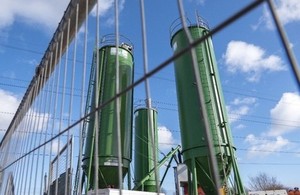Technical guidance note released following subsidence event
Coal Authority releases technical guidance note following subsidence event in north-east England.

The Coal Authority has today issued a technical guidance note, following completion of its review of findings into a large subsidence event in north-east England.
The government body, which manages the effects of past coal mining across Britain, said it had issued the note following successful completion of the engineering works and following a sustained period of monitoring
James Lowth, Operations Director at the Coal Authority, said: “Following the release of our initial recommendations last year, we have published further details to ensure awareness of the risks posed by historical coal mining legacy.
“Our technical guidance note builds on our initial recommendations, and is relevant to local authority planners, surveyors, developers and geotechnical and engineering consultants, for when they are considering coal mining legacy issues.”
Mark Bettney, Head of Engineering, Coal Authority, confirmed that this subsidence event was caused from roof and pillar failure within the mine workings.
He added: “The weak, laminated, weathered and fractured sandstone, which formed the roof of the workings had progressively deteriorated since the mine workings were abandoned. As the deterioration increased, it redistributed the loading on the remaining coal pillars.
“The coal pillars would have been of marginal stability at the time of mining due to the high degree of extraction, and the resulting failure of the remaining coal pillars led to the ground movements and subsidence at the surface.”
The Coal Authority also reiterated its earlier statement that “caution must be adopted in assuming that the absence of a record means the absence of mining”.
Whilst its historical plans in this case did not reveal the coal workings, they are a vital part of any site assessment prior to development.
It added that in future “we may ask for more information, or for more works to take place, to reduce the likelihood of a similar subsidence event happening again”.
View the Coal Authority’s Technical Guidance Note TGN01
For media enquiries contact the community response team
200 Lichfield Lane
Mansfield
Nottinghamshire
NG18 4RG
Email [email protected]
Telephone 0800 288 4211
For emergency media enquiries (out of hours) call: 0800 288 4242.
Only urgent media calls will be attended to.
Notes to editors
Background to the subsidence event
In July 2016, the Coal Authority carried out initial ground investigations at a housing development in the north-east of England after it was contacted by the National House Building Council.
The Coal Authority carried out further extensive ground investigations, including underground camera and laser void surveys, to identify the root cause of the subsidence. It also installed 300 survey points above and below the ground to monitor for ground and property movement.
The Coal Authority’s ground investigations revealed coal mine workings at a depth in excess of 30 metres. The workings dated back around 120 years and had not been recorded on the historical mining plans held by the authority.
The ground investigations proved this specific area had been extensively worked with extraction rates at over 75%, however the plans had showed an area of solid coal. Recorded workings adjacent to this area had typical extraction rates of between 45% and 50%.
This high level of extraction resulted in narrow residual supporting coal pillars and wide extraction rooms in the High Main coal seam, leading to compression on the remaining coal pillars and roof instability.
This, together with a weak, laminated, weathered and fractured sandstone layer above the coal seam, resulted in an underground collapse and subsequent movement at the surface that affected a number of properties and had an elliptical subsidence zone footprint of around 150 metres x 70 metres.
Coal Authority engineers designed a solution to stabilise the ground, and work to drill and grout the voids was completed over a 5 month programme of works. The Coal Authority continues to monitor the ground since the works have been completed to ensure the ground is stable for redevelopment.
About the Coal Authority
The Coal Authority is a non-departmental public body, which is sponsored by the Department for Business, Energy and Industrial Strategy. It was set up in 1994, and it manages the effects of past coal mining, including subsidence damage claims and other coal mining legacy issues in Britain.
The legislation relating to coal mining subsidence damage is contained in the Coal Mining Subsidence Act 1991, amended by the Coal Industry Act 1994.
For more information please visit www.gov.uk/coalauthority or to report a coal mine hazard or incident phone 01623 646333.